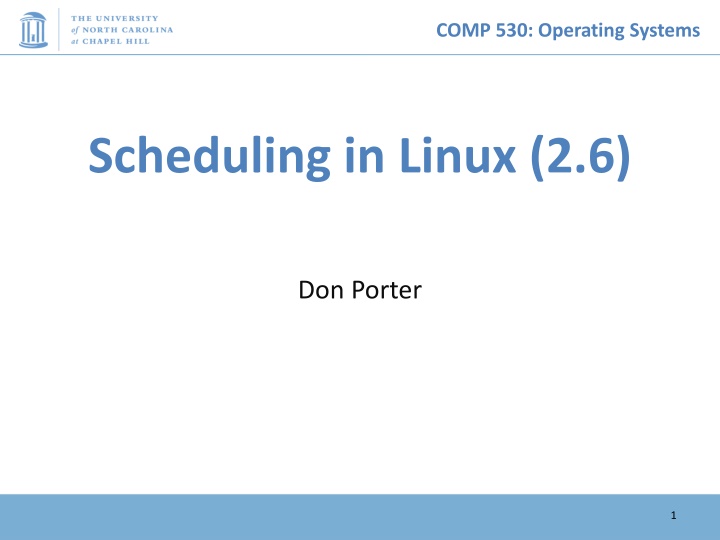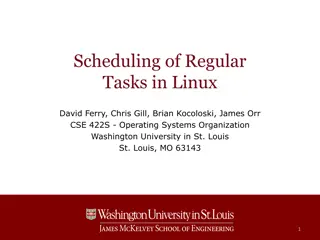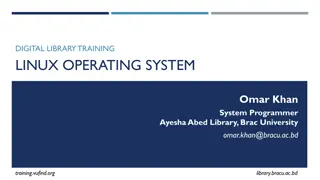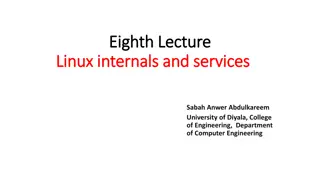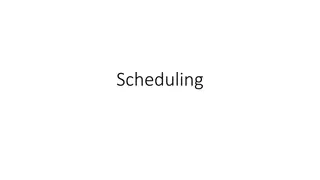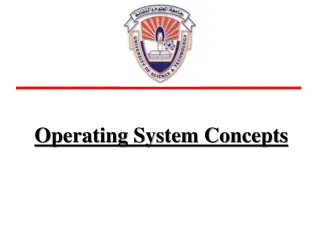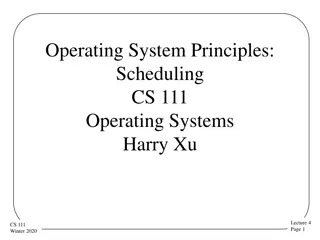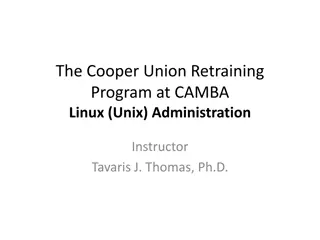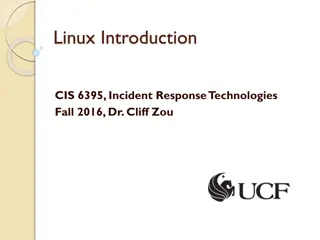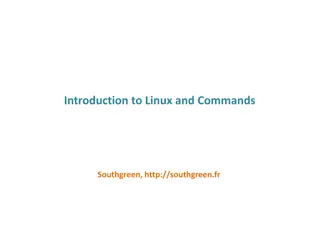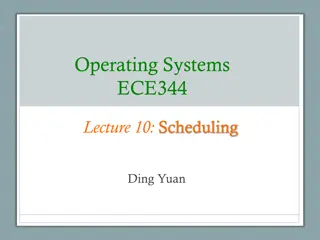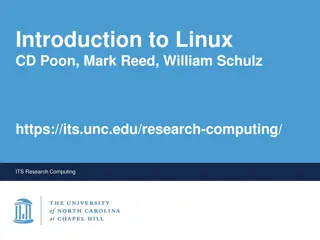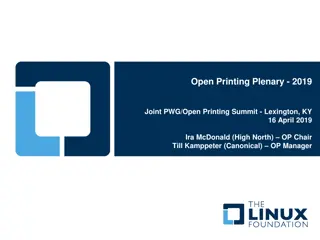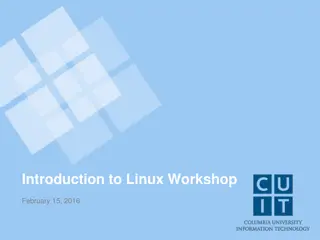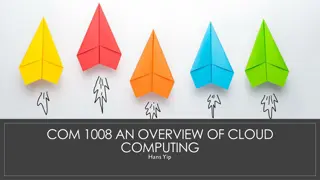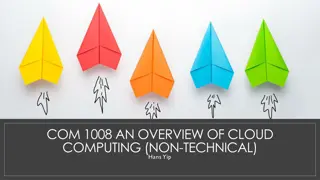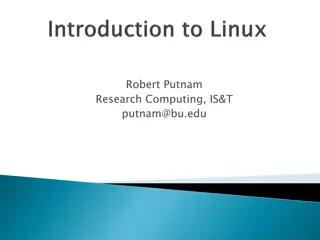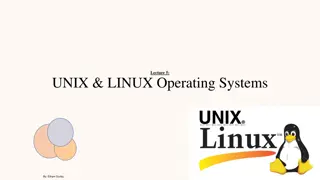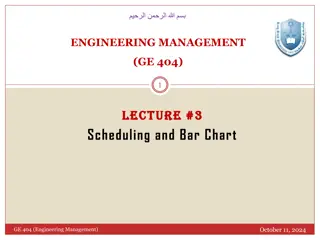Linux Operating System Scheduling Algorithms Overview
Delve into the high-level theory of scheduling algorithms in Linux, focusing on the multi-level feedback queue approach. Explore how Linux makes scheduling decisions and understand the low-level building blocks of the O(1) scheduler. Dive into terminology, policy goals, and the challenges of optimizing multiple variables in the context of operating system scheduling.
Uploaded on Mar 15, 2025 | 1 Views
Download Presentation

Please find below an Image/Link to download the presentation.
The content on the website is provided AS IS for your information and personal use only. It may not be sold, licensed, or shared on other websites without obtaining consent from the author.If you encounter any issues during the download, it is possible that the publisher has removed the file from their server.
You are allowed to download the files provided on this website for personal or commercial use, subject to the condition that they are used lawfully. All files are the property of their respective owners.
The content on the website is provided AS IS for your information and personal use only. It may not be sold, licensed, or shared on other websites without obtaining consent from the author.
E N D
Presentation Transcript
COMP 530: Operating Systems Scheduling in Linux (2.6) Don Porter 1
COMP 530: Operating Systems Last time We went through the high-level theory of scheduling algorithms One approach was a multi-level feedback queue Today: View into how Linux makes its scheduling decisions Note: a bit dated this is from v2.6, but I think still pedagogically useful and more accessible than the new approach
COMP 530: Operating Systems Lecture goals Understand low-level building blocks of a scheduler Understand competing policy goals Understand the O(1) scheduler
COMP 530: Operating Systems (Linux) Terminology Map task a Linux PCB Really represents a thread in the kernel (more on threads next lecture) Quantum CPU timeslice Quanta is plural, for those whose Latin is dusty
COMP 530: Operating Systems Outline Policy goals (review) O(1) Scheduler
COMP 530: Operating Systems Policy goals Fairness everything gets a fair share of the CPU Real-time deadlines CPU time before a deadline more valuable than time after Latency vs. Throughput: Timeslice length matters! GUI programs should feel responsive CPU-bound jobs want long timeslices, better throughput User priorities Virus scanning is nice, but I don t want it slowing things down
COMP 530: Operating Systems No perfect solution Optimizing multiple variables Like memory allocation, this is best-effort Some workloads prefer some scheduling strategies Nonetheless, some solutions are generally better than others
COMP 530: Operating Systems Outline Policy goals O(1) Scheduler
COMP 530: Operating Systems O(1) scheduler Goal: decide who to run next, independent of number of processes in system Still maintain ability to prioritize tasks, handle partially unused quanta, etc
COMP 530: Operating Systems O(1) Bookkeeping runqueue: a list of runnable tasks Blocked processes are not on any runqueue A runqueue belongs to a specific CPU Each task is on exactly one runqueue Task only scheduled on runqueue s CPU unless migrated 2 *40 * #CPUs runqueues 40 dynamic priority levels (more later) 2 sets of runqueues one active and one expired
COMP 530: Operating Systems O(1) Data Structures Expired Active 139 139 138 138 137 ... 137 ... 101 101 100 100
COMP 530: Operating Systems O(1) Intuition Take the first task off the lowest-numbered runqueue on active set Confusingly: a lower priority value means higher priority When done, put it on appropriate runqueue on expired set Once active is completely empty, swap which set of runqueues is active and expired Constant time , since fixed number of queues to check; only take first item from non-empty queue
COMP 530: Operating Systems O(1) Example Expired Active 139 139 138 138 Move to expired queue when quantum expires 137 ... Pick first, highest priority task to run 137 ... 101 101 100 100
COMP 530: Operating Systems What now? Expired Active 139 139 138 138 137 ... 137 ... 101 101 100 100
COMP 530: Operating Systems Blocked Tasks What if a program blocks on I/O, say for the disk? It still has part of its quantum left Not runnable, so don t waste time putting it on the active or expired runqueues We need a wait queue associated with each blockable event Disk, lock, pipe, network socket, etc.
COMP 530: Operating Systems Blocking Example Disk Expired Active 139 139 Block on disk! 138 138 137 ... 137 ... Process goes on disk wait queue 101 101 100 100
COMP 530: Operating Systems Blocked Tasks, cont. A blocked task is moved to a wait queue until the expected event happens No longer on any active or expired queue! Disk example: After I/O completes, interrupt handler moves task back to active runqueue
COMP 530: Operating Systems Time slice tracking If a process blocks and then becomes runnable, how do we know how much time it had left? Each task tracks ticks left in time_slice field On each clock tick: current->time_slice-- If time slice goes to zero, move to expired queue Refill time slice Schedule someone else An unblocked task can use balance of time slice Forking halves time slice with child
COMP 530: Operating Systems More on priorities 100 = highest priority 139 = lowest priority 120 = base priority nice value: user-specified adjustment to base priority Selfish (not nice) = -20 (I want to go first) Really nice = +19 (I will go last)
COMP 530: Operating Systems Base time slice (140- prio)*20ms prio<120 time= (140- prio)*5ms prio 120 Higher priority tasks get longer time slices And run first Don t worry about memorizing these formulae
COMP 530: Operating Systems Goal: Responsive UIs Most GUI programs are I/O bound on the user Unlikely to use entire time slice Users get annoyed when they type a key and it takes a long time to appear Idea: give UI programs a priority boost Go to front of line, run briefly, block on I/O again Which ones are the UI programs?
COMP 530: Operating Systems Idea: Infer from sleep time By definition, I/O bound applications spend most of their time waiting on I/O We can monitor I/O wait time and infer which programs are GUI (and disk intensive) Give these applications a priority boost Note that this behavior can be dynamic Ex: GUI configures DVD ripping, then it is CPU-bound Scheduling should match program phases
COMP 530: Operating Systems Dynamic priority dynamic priority = max ( 100, min ( static priority bonus + 5, 139 ) ) Bonus is calculated based on sleep time Dynamic priority determines a tasks runqueue This is a heuristic to balance competing goals of CPU throughput and latency in dealing with infrequent I/O May not be optimal
COMP 530: Operating Systems Dynamic Priority in O(1) Scheduler Important: The runqueue a process goes in is determined by the dynamic priority, not the static priority Dynamic priority is mostly determined by time spent waiting, to boost UI responsiveness Nice values influence static priority No matter how nice you are (or aren t), you can t boost your dynamic priority without blocking on a wait queue!
COMP 530: Operating Systems Rebalancing tasks As described, once a task ends up in one CPU s runqueue, it stays on that CPU forever
COMP 530: Operating Systems Rebalancing CPU 1 CPU 0 CPU 1 Needs More Work! ... ...
COMP 530: Operating Systems Rebalancing tasks As described, once a task ends up in one CPU s runqueue, it stays on that CPU forever What if all the processes on CPU 0 exit, and all of the processes on CPU 1 fork more children? We need to periodically rebalance Balance overheads against benefits Figuring out where to move tasks isn t free
COMP 530: Operating Systems Idea: Idle CPUs rebalance If a CPU is out of runnable tasks, it should take load from busy CPUs Busy CPUs shouldn t lose time finding idle CPUs to take their work if possible There may not be any idle CPUs Overhead to figure out whether other idle CPUs exist Just have busy CPUs rebalance much less frequently
COMP 530: Operating Systems Average load How do we measure how busy a CPU is? Average number of runnable tasks over time Available in /proc/loadavg
COMP 530: Operating Systems Rebalancing strategy Read the loadavg of each CPU Find the one with the highest loadavg (Hand waving) Figure out how many tasks we could take If worth it, lock the CPU s runqueues and take them If not, try again later
COMP 530: Operating Systems Editorial Note O(1) scheduler is not constant time if you consider rebalancing costs But whatevs: Execution time to pick next process is one of only several criteria for selecting a scheduling algorithm O(1) was later replaced by a logarithmic time algorithm (Completely Fair Scheduler), that was much simpler More elegantly captured these policy goals Amusingly, not completely fair in practice 31
COMP 530: Operating Systems Summary Understand competing scheduling goals Understand O(1) scheduler + rebalancing
